Do you have a question about the Craftsman 917.371813 and is the answer not in the manual?
Details the terms of the 2-year full warranty for manufacturer defects in material or workmanship.
Highlights the machine's potential for severe injury or death if safety instructions are not followed.
Instructs to disconnect the spark plug wire to prevent accidental engine starts during maintenance or setup.
Alerts users to hot engine parts like the muffler and advises caution to prevent burns.
Warns users to keep hands and feet away from rotating parts and the discharge opening.
Instructs to clear the mowing area of debris that could be thrown by the blade.
Mandates operating the mower only with all safety guards and devices properly installed and in place.
Requires wearing safety goggles or glasses with side shields for eye protection during operation.
Highlights slopes as a significant hazard for slips and falls, advising extra caution and avoiding uneasy slopes.
Instructs to mow across slopes, not up and down, and exercise caution when changing direction.
Emphasizes the risk of accidents if operators are not alert to the presence of children.
Instructs to keep children out of the mowing area and supervised by another adult.
Advises turning off the mower immediately if children enter the mowing area.
Strictly prohibits children from operating the lawn mower under any circumstances.
Warns about the extreme flammability and explosive vapors of gasoline, requiring extreme care.
Instructs to extinguish all sources of ignition, such as cigarettes and open flames, when handling gasoline.
Advises against refueling with the engine running and to let the engine cool before adding fuel.
Prohibits refueling the lawn mower inside any building or enclosure.
Warns against storing the mower or fuel near open flames, sparks, or pilot lights.
Instructs to fill fuel containers on the ground, away from vehicles, to prevent static discharge.
Prohibits running the mower in enclosed areas due to exhaust fumes.
Emphasizes disconnecting the spark plug wire before making adjustments or repairs to prevent accidental starting.
Warns against tampering with safety devices and stresses regular checks of their operation.
Requires stopping and inspecting the mower after striking an object before restarting.
Warns that mower blades are sharp and require gloves or wrapping for safe servicing.
Alerts users that the mower is shipped without oil or gasoline, requiring them to be added before use.
Guides users to familiarize themselves with mower controls and adjustments by comparing illustrations.
Explains various symbols used on the mower and in its literature, emphasizing their meaning.
Explains the function of the operator presence control bar for starting and stopping the engine.
Describes the drive control lever used for engaging the mower's self-propelled forward motion.
Warns about the risk of eye injury from thrown objects and recommends wearing safety glasses.
Details how to engage and control the self-propelled drive system of the mower.
Warns against operating the mower without the mulcher door, deflector, or discharge chute/catcher properly in place.
Details the procedure for adding the correct type and amount of oil to the engine.
Explains how to safely add fresh, unleaded gasoline to the mower's fuel tank.
Warns to wipe up spills and keep gasoline away from open flames or sparks.
Details the steps for starting the engine, involving the control bar and starter handle.
Check the engine oil level before each use and after every 5 hours of operation.
Change engine oil every 25 operating hours or annually, more often in dusty conditions.
Clean the air filter every 10 operating hours, or more often in dusty conditions.
Check the engine oil level before each use to prevent damage.
Emphasizes keeping the mower blade sharp and replacing bent or damaged blades.
Warns to use only manufacturer-approved replacement blades for safety and to prevent damage.
Details the recommended oil type, viscosity grades, and checks for engine lubrication.
Recommends changing engine oil every 25 operating hours or at least annually.
Instructs to check the engine oil level before starting and after every 5 hours of use.
Provides a step-by-step guide for draining and refilling the engine oil.
Explains the importance of the air filter and how to clean or replace it.
Warns to disconnect the spark plug wire before cleaning to prevent accidental starting.
Lists essential safety precautions to take before performing any service or adjustments on the mower.
Provides instructions for preparing the fuel system for storage, emphasizing preventing gum deposits.
Stresses the importance of preventing gum deposits in fuel system parts during storage.
Details the process of emptying the fuel tank and carburetor for long-term storage.
Warns against storing a mower with fuel in a building where fumes could reach ignition sources.
Lists common causes and corrections for the mower failing to start.
Identifies causes and solutions for the mower experiencing a loss of power.
Lists reasons for an uneven cut and provides corrective actions.
Details causes of excessive vibration and suggests remedies, including professional service.
Explains why the starter rope might be hard to pull and how to fix it.
Identifies issues with the drive system speed and provides troubleshooting steps.
Details the terms of the 2-year full warranty for manufacturer defects in material or workmanship.
Highlights the machine's potential for severe injury or death if safety instructions are not followed.
Instructs to disconnect the spark plug wire to prevent accidental engine starts during maintenance or setup.
Alerts users to hot engine parts like the muffler and advises caution to prevent burns.
Warns users to keep hands and feet away from rotating parts and the discharge opening.
Instructs to clear the mowing area of debris that could be thrown by the blade.
Mandates operating the mower only with all safety guards and devices properly installed and in place.
Requires wearing safety goggles or glasses with side shields for eye protection during operation.
Highlights slopes as a significant hazard for slips and falls, advising extra caution and avoiding uneasy slopes.
Instructs to mow across slopes, not up and down, and exercise caution when changing direction.
Emphasizes the risk of accidents if operators are not alert to the presence of children.
Instructs to keep children out of the mowing area and supervised by another adult.
Advises turning off the mower immediately if children enter the mowing area.
Strictly prohibits children from operating the lawn mower under any circumstances.
Warns about the extreme flammability and explosive vapors of gasoline, requiring extreme care.
Instructs to extinguish all sources of ignition, such as cigarettes and open flames, when handling gasoline.
Advises against refueling with the engine running and to let the engine cool before adding fuel.
Prohibits refueling the lawn mower inside any building or enclosure.
Warns against storing the mower or fuel near open flames, sparks, or pilot lights.
Instructs to fill fuel containers on the ground, away from vehicles, to prevent static discharge.
Prohibits running the mower in enclosed areas due to exhaust fumes.
Emphasizes disconnecting the spark plug wire before making adjustments or repairs to prevent accidental starting.
Warns against tampering with safety devices and stresses regular checks of their operation.
Requires stopping and inspecting the mower after striking an object before restarting.
Warns that mower blades are sharp and require gloves or wrapping for safe servicing.
Alerts users that the mower is shipped without oil or gasoline, requiring them to be added before use.
Guides users to familiarize themselves with mower controls and adjustments by comparing illustrations.
Explains various symbols used on the mower and in its literature, emphasizing their meaning.
Explains the function of the operator presence control bar for starting and stopping the engine.
Describes the drive control lever used for engaging the mower's self-propelled forward motion.
Warns about the risk of eye injury from thrown objects and recommends wearing safety glasses.
Details how to engage and control the self-propelled drive system of the mower.
Warns against operating the mower without the mulcher door, deflector, or discharge chute/catcher properly in place.
Details the procedure for adding the correct type and amount of oil to the engine.
Explains how to safely add fresh, unleaded gasoline to the mower's fuel tank.
Warns to wipe up spills and keep gasoline away from open flames or sparks.
Details the steps for starting the engine, involving the control bar and starter handle.
Check the engine oil level before each use and after every 5 hours of operation.
Change engine oil every 25 operating hours or annually, more often in dusty conditions.
Clean the air filter every 10 operating hours, or more often in dusty conditions.
Check the engine oil level before each use to prevent damage.
Emphasizes keeping the mower blade sharp and replacing bent or damaged blades.
Warns to use only manufacturer-approved replacement blades for safety and to prevent damage.
Details the recommended oil type, viscosity grades, and checks for engine lubrication.
Recommends changing engine oil every 25 operating hours or at least annually.
Instructs to check the engine oil level before starting and after every 5 hours of use.
Provides a step-by-step guide for draining and refilling the engine oil.
Explains the importance of the air filter and how to clean or replace it.
Warns to disconnect the spark plug wire before cleaning to prevent accidental starting.
Lists essential safety precautions to take before performing any service or adjustments on the mower.
Provides instructions for preparing the fuel system for storage, emphasizing preventing gum deposits.
Stresses the importance of preventing gum deposits in fuel system parts during storage.
Details the process of emptying the fuel tank and carburetor for long-term storage.
Warns against storing a mower with fuel in a building where fumes could reach ignition sources.
Lists common causes and corrections for the mower failing to start.
Identifies causes and solutions for the mower experiencing a loss of power.
Lists reasons for an uneven cut and provides corrective actions.
Details causes of excessive vibration and suggests remedies, including professional service.
Explains why the starter rope might be hard to pull and how to fix it.
Identifies issues with the drive system speed and provides troubleshooting steps.
| Engine Brand | Briggs & Stratton |
|---|---|
| Cutting Width | 21 inches |
| Cutting Height Positions | 6 |
| Deck Material | Steel |
| Starting System | Recoil |
| Fuel Tank Capacity | 1.6 qt. |
| Weight | 65 lbs |
| Transmission | Single-Speed |
| Engine Type | 4-Cycle |
| Cutting Height Range | 1.25 to 3.75 inches |
| Wheel Size | 7 in. (front) / 8 in. (rear) |
| Grass Discharge | Side, Mulch, Rear Bag |
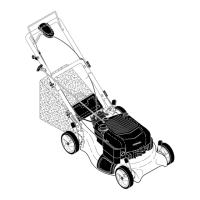



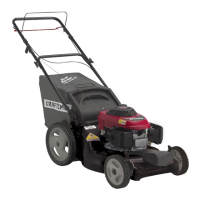
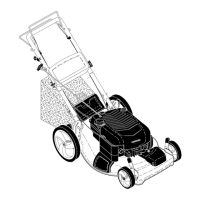
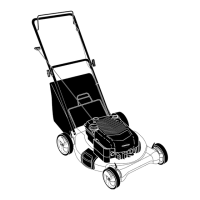
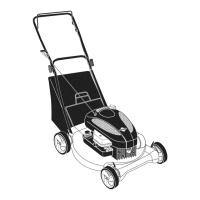


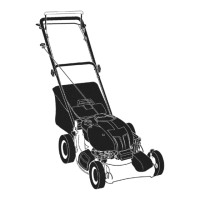
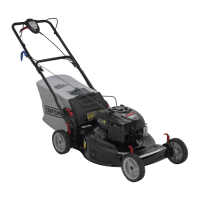
